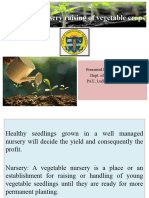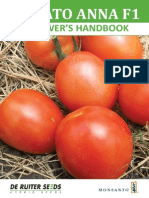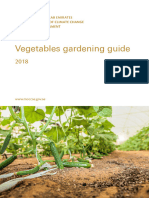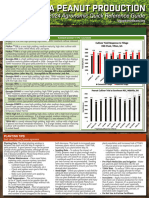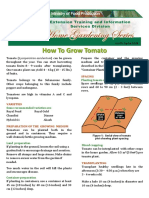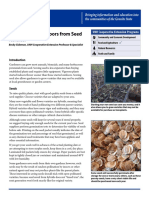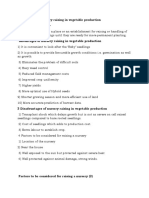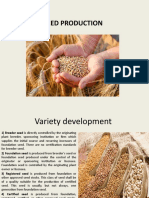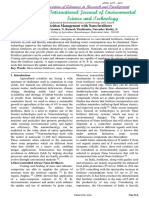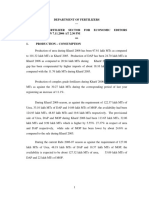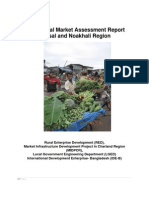0 ratings0% found this document useful (0 votes)
8 viewsTomato Production
Tomato Production
Uploaded by
Chery SumagaysayTomato production requires a climate with temperatures between 21-24°C and well-draining soil. Tomatoes are a good source of vitamins and minerals. Seedlings are grown for 25 days before transplanting with support. Plants require regular watering and fertilizing. Pests include whiteflies and diseases like bacterial wilt. Tomatoes are harvested when they start to change color, taking care not to bruise the fruits.
Copyright:
© All Rights Reserved
Available Formats
Download as DOCX, PDF, TXT or read online from Scribd
Tomato Production
Tomato Production
Uploaded by
Chery Sumagaysay0 ratings0% found this document useful (0 votes)
8 views7 pagesTomato production requires a climate with temperatures between 21-24°C and well-draining soil. Tomatoes are a good source of vitamins and minerals. Seedlings are grown for 25 days before transplanting with support. Plants require regular watering and fertilizing. Pests include whiteflies and diseases like bacterial wilt. Tomatoes are harvested when they start to change color, taking care not to bruise the fruits.
Original Description:
growing tomato
Original Title
TOMATO_PRODUCTION
Copyright
© © All Rights Reserved
Available Formats
DOCX, PDF, TXT or read online from Scribd
Share this document
Did you find this document useful?
Is this content inappropriate?
Tomato production requires a climate with temperatures between 21-24°C and well-draining soil. Tomatoes are a good source of vitamins and minerals. Seedlings are grown for 25 days before transplanting with support. Plants require regular watering and fertilizing. Pests include whiteflies and diseases like bacterial wilt. Tomatoes are harvested when they start to change color, taking care not to bruise the fruits.
Copyright:
© All Rights Reserved
Available Formats
Download as DOCX, PDF, TXT or read online from Scribd
Download as docx, pdf, or txt
0 ratings0% found this document useful (0 votes)
8 views7 pagesTomato Production
Tomato Production
Uploaded by
Chery SumagaysayTomato production requires a climate with temperatures between 21-24°C and well-draining soil. Tomatoes are a good source of vitamins and minerals. Seedlings are grown for 25 days before transplanting with support. Plants require regular watering and fertilizing. Pests include whiteflies and diseases like bacterial wilt. Tomatoes are harvested when they start to change color, taking care not to bruise the fruits.
Copyright:
© All Rights Reserved
Available Formats
Download as DOCX, PDF, TXT or read online from Scribd
Download as docx, pdf, or txt
You are on page 1of 7
TOMATO PRODUCTION
Tomato (Lycopersicum esculentum) is popularly grown in most parts of the
country. It’s a good source of Vitamins A and C. It also contains dietary fiber,
beta carotene, iron, lycopene, magnesium, niacin, potassium, phosphorous,
riboflavin and thiamine. It is also rich in anti-oxidant, good for the heart, helps
prevent premature aging and reduces the
risk of chronic diseases. probiotics preparations like IMO,
Vermitea, FAA, OHN and FPJ during
Climatic and Soil Requirement vegetative stage. During reproductive
• Tomatoes require a cool and dry climate stage, apply FFJ, CalPhos or OHN to
with temperature ranging from 21 to 24 support flower & fruit development.
°C. For colder areas, plant from
September to January and November to • For non-organic production, to boost
February in lowland areas. seedling growth dissolve 1 tbsp. of urea
• Tomatoes grow well in sandy-loam to in 1 gal. of water and drench this to the
seedlings 1 week before transplanting.
clay-loam soils with rich organic matter,
good drainage and a pH ranging from
5.5 to 8.0.
• A well-pulverized soil promoted good
aeration and enhances root formation.
During transplanting add 1 tbsp. of
complete fertilizer (14-14-14) in the hole
Soil Preparation then cover it with a handful of compost
• Prepare a potting medium by mixing 1 prior to planting. Two weeks after
part garden soil, 1 part carbonized rice planting, apply 1 tbsp. of urea (46-0-0)
hull and 1 part compost or organic and 1 tbsp. of muriate of potash (0-0-60)
fertilizer. by burying them in a 1-inch deep hole 3-
• Use potting medium measuring 8 inches 4 inches away from the stem. Repeat
in diameter with 10 inches in height. The application of urea and potash at
bigger the pot the better. 30DAT.
Raising Seedlings and Planting Trellising
• Before sowing, soak seeds overnight, Tomatoes grown in containers usually
sow immediately or air-dry the seeds require support to hold them upright.
before sowing. Support the seedlings with trellis at 15
• Fill the seeds tray with mixed media days after transplanting using locally
then sow one seed per hole at a depth available materials.
of 0.5cm, cover the seeds with fine soil
then water.
Water Management
• Transplant the seedlings 25 days to one
month after emergence. Water the plants as the need arises.
Tomato is very sensitive to flooding,
hence, watering must be done just to
Water and Nutrient Management
moisten the root zone especially during
• Tomato is sensitive to excessive
the start of flowering up to the last
moisture because it triggers disease
harvest.
development like blight. That is why the
occurrence of blight in rainy season is
prevalent. Make sure the pot should Pruning
have enough holes for good drainage. • Pruning is done to attain better plant
Water the plants regularly every after 1- growth. It can be done 10 to 20 DAT or
2 days and every time you apply when the side shoot or suckers start to
fertilizer. elongate.
• Pinch or cut suckers using pruners
• Before transplanting, add a handful of while these are small. Prune in the
compost/ vermicast/manure to the hole morning to hasten healing of plant
as basal fertilizer. To boost plant vigor, wounds.
apply weekly (spray or drench) organic
Pest Management that have begun changing color)
• Whiteflies, thrips and fruit borer are the and bulk harvesting of mature
common insect pests of tomatoes, while green tomatoes.
bacterial wilt, blights caused by fungi
and mosaic virus are its common Good harvesting management is
diseases. For insects, you can use OHN needed to pick high quality
and other botanical pesticide tomatoes. Care must be taken
preparations such as hot pepper and when harvesting “breaker” stage
lemon grass extracts, ginger extract, fruit because the riper the tomato,
tomato extract and others. For diseases,
the more susceptible it is to
you can use OHN and other botanical
bruising. Harvest crews should
fungicides such as extracts of onion ,
carefully place fruits into picking
ipil-ipil, kamantigi and takip kuhol.
There’s no remedy for the mosaic virus containers instead of dropping
but to uproot the plant to lessen sources them. Research has demonstrated
of inoculum (causal agent). that a drop of more than 6 inches
onto a hard surface can cause
• Aside from spraying botanical internal bruising that is not evident
pesticides, growing aromatic crops like until after the tomato is cut open.
basil, allium, ginger, lemon grass and Bruising is characterized by water-
marigold can help repel insects. soaked cellular breakdown of the
Likewise, growing cosmos, sunflower
cross-wall and locular (seed cavity)
and zinnia attracts beneficial insects.
Sanitation or removing diseased or area. External bruising will be
damaged plant or its parts and burying caused if pickers hurl or dump
them also helps. tomatoes too vigorously from the
• For non-organic production, you can use picking bucket into unpadded bulk
appropriate chemical pesticides
available in the market.
bins. Bins should never be over-
loaded because excessive tomato
Harvesting weight will cause bruise damage
The key to harvesting the most flavorful due to compression. Harvested
tomato is to wait for the fruits to fully ripen tomatoes must be shaded to
on the plant.
minimize heat-up while waiting for
The fruits are ready to harvest when it starts
to change color from green to pinkish red or pallet bin dumping at the
yellow, depending on the variety. packinghouse. Research has shown
Fresh market tomatoes are that bulk bin tomatoes held in the
harvested by hand in Georgia. The hot sun for just one hour can be as
harvesting operation varies much as 25 degrees F warmer than
somewhat among growers. Mature-
fruit held in the shade. Field heat
green harvested tomatoes are
placed into polyethylene picking can speed up breakdown after
buckets that are carried to a flatbed packing.
trailer where the fruit is dumped into
plastic bulk bins. Pickers should do preliminary
Each bin holds between 800 and grading to remove decayed fruit
1,200 pounds of fresh fruit, and the
from the plants as they harvest the
trailer is positioned in the field so
pickers only have to walk a minimal field. This will prevent crossover
distance to reach a bin. disease contamination to
Once all bins are loaded, they are otherwise healthy, sound fruit. Wet
transported to a centralized tomatoes should never be
packinghouse where the fruit is harvested, because surface
washed, sized and packed out.
moisture increases field heat
Some growers avoid use of bulk
bins because of potential damage accumulations in the load and
to the fruit and field pack tomatoes enhances disease development.
into boxes. Some growers also
combine the two approaches, with
field packing of “pinks” (tomatoes
All picking buckets should be When tomatoes are physically
cleaned and sanitized at the end of injured during handling, disease
each harvest day to prevent the organisms can easily invade the
potential accumulation of disease flesh, setting up decay. As decay
organisms from infecting sound due to bruising was the greatest
fruit picked the next production contributor to tomato loss in
day. Rinse buckets with water to marketing channels.
remove soil and field debris, then
wash them in a sanitizing solution Tomatoes are scuffed and scarred
consisting of 5 oz. of household when they rub against rough
bleach (5.25 percent sodium surfaces, such as bin boxes, pack
hypochlorite) mixed in 5 gallons of out cartons, dirty sorting belts, or
water. even against each other,
particularly when dirty. Tomatoes
Postharvest Handling below about 60 degrees F scuff
The importance of care in handling more easily than warm fruit.
tomatoes between the time of harvest and Scuffing and scarring are followed
shipping to market cannot be by pitting and browning, because
overemphasized, since about half of the the injured tissue dries out.
cost of tomato production is in the grading,
cooling and packing of the product. Tomatoes may be bruised any time
Bulk bins of harvested tomatoes are between field and kitchen by being
taken from the field to the packing (1) thrown into picking box or bin;
house, where they are mechanically (2) pressed out of shape in a bin
unloaded in a water dump tank or loaded too deeply; (3) dumped too
concrete pit. Water jets convey the vigorously from box or bin onto
fruit by flume onto an inclined sorting belt, or dropped too far
dewatering roller belt with soft from sorting belt to shipping
bristle brushes that remove field container; (4) squashed during
debris. The fruit is then dried, pre- stacking, loading or in transit; (5)
graded, color sorted and sized handled roughly during sorting in
before being jumble-packed into the ripening room or during
25-pound fiberboard cartons. prepacking; (6) dumped into bulk
retail display; or (7) squeezed in the
Mechanical damage (i.e., cuts, hand of the customer or between
punctures, bruises, scars, scuff harder items in the grocery bag.
marks and discolored areas)
accounts for more defects at the
Sorting
shipping point and in the market
than all other defects combined. Of
After harvest, farmers should sort tomatoes
these, bruises are the most
to remove diseased, rotten, cracked,
common and serious, comprising
unattractive, discolored, and pest-infested
about half of all mechanical
fruits. Sorting is done in a cool and shaded
damage. Bruised tomatoes may be
environment. The best tomatoes can be put
flattened or indented and soft; the
in stackable plastic crates.
locules either are dry or, if
gelatinous tissue is present, it may
Sorting and grading
be thick and stringy from
continuous pressure or watery from
severe impacts.
After harvesting tomatoes when firm and
red, they are washed, sorted, and graded to To ensure a good financial return, farmers
meet the buyer’s requirements. must carefully time their production and
marketing. If many farmers mass produce in
Tomatoes are sorted to separate diseased, one season, there is a glut in the market
rotten, cracked, or “unattractive” tomatoes. and prices drop, which results in spoilage,
Tomatoes are graded by size, colour, waste, and financial losses. Therefore, it’s
maturity, quality, uniformity, variety, and recommended that farmers stagger their
stage of ripening. production during the on-season to meet
Sort and grade in a cool and clean market and take advantage of the lean
environment, and ensure that people period to grow tomatoes (i.e., wet season
sorting and grading ensure cleanliness by, production in Nigeria.)
for example, washing their hands and Greenhouse versus field
wearing clean clothes.
An ideal cluster of tomatoes is well-shaped, Farmers who grow tomatoes in
uniform in size and colour, and with fruits greenhouses can more easily time their
free from diseases, blemishes, spray growing cycles than those who grow
residues, and cracks. tomatoes in fields and must rely on
A crate of tomatoes can be washed in rainwater.
sodium bicarbonate (baking soda). Twenty Greenhouse growers can grow all year
grams per litre of water can be used to round, and earn more than those who farm
wash the tomatoes to minimize post- in open fields.
harvest rot. In Kenya and Nigeria, greenhouse growers
Grading classes may vary by country. In who have mature tomatoes at the onset of
some countries, there are four grade classes the rainy season earn more due to the
for tomatoes: class 1, 2, 3, plus the lowest scarcity of tomatoes in the market at that
class. The first three classes have no decay, time, compared to those who rely on rains.
foreign matter, foreign odours, insect Many smallholder farmers lack the initial
damage, deformities, or injuries. capital or collateral to access loans needed
to purchase and set up greenhouses.
Class 1: Tomatoes are at least 50
millimetres in diameter, fairly firm, not Packaging
overripe, fairly uniform in size and colour,
well-shaped, and attractive. Tomatoes can be packaged in cartons, sisal
Class 2: Tomatoes are at least 40 baskets, wooden boxes, and cardboard or
millimetres in diameter, reasonably firm, plastic crates or boxes, and padded with
not overripe, attractive, and reasonably banana leaves to cushion them from
well-shaped and uniform in size and colour. damage during transport. Packing in raffia
Class 3: Tomatoes are at least 30 baskets is highly discouraged as it
millimetres in diameter, are firm, attractive contributes to post-harvest losses.
(no spots or skin damage), and have
different sizes and colour. Harvest to market
Tomatoes can also be graded into three
weight classes. Small tomatoes are less than Tomatoes are ready to harvest 3-4 months
100 grams, medium-sized tomatoes weigh after sowing, depending on the variety.
100 to 255 grams, and large tomatoes are After harvest, farmers sort and grade the
over 255 grams. Local retailers use these tomatoes to meet the buyers’ standards
grading classes when selling at local and needs.
markets. Wash or wipe the tomatoes to ensure they
are clean.
Seasonal production
Tomatoes can be stored in plastic crates in a or consume, they can dry tomatoes to
well-fumigated room such as an evaporative preserve them and minimize post-harvest
cooling chamber, a cold room with losses. The best tomato varieties for drying
temperatures of 10-15⁰C that maintains are firm plum or paste varieties, for
humidity at 95%. Farmer can choose to sell example, Roma and UC82B. Tomatoes can
tomatoes at the farm gate to local buyers be sun-dried in the open air or artificially
like middlemen, or they can transport them dried. Before drying, disinfect tomatoes by
to the market. Aggregation and bulk selling dipping them in boiling water for 1-2
give farmers greater bargaining power. minutes.
Transport Open air drying: Wash tomatoes, cut in
halves or quarters, and place on clean
Inappropriate modes of transportation tarpaulins or other flat surfaces with the cut
result in tomato losses. When packaging side facing the sun—for example, trays on a
materials do not immobilize fruits, excessive raised surface and covered with plastic
vibration or movement leads to losses mesh. Plastic mesh, mosquito nets, or
during transport. cotton muslin cloth prevents contamination
Whenever possible, farmers should use by insects, dirt, and dust. Open-air drying
refrigerated trucks to transport tomatoes. If takes 2-5 days when it’s windy and the air is
they are unavailable, cover non-refrigerated not humid. The result is pieces of dark, red,
trucks with jute spreads or tarpaulins to leathery tomato with 15-20% moisture
protect tomatoes from transpiration. content. If dried further, moisture content
Tomatoes can also be packed in wooden or is reduced to 5% and the dried, hard, brittle
plastic crates/lugs or cartons in trucks. tomato pieces can be crushed to powder or
Transporting tomatoes in returnable plastic flakes and used in soups and sauces.
crates reduces losses even on bad roads Tomatoes stored as powder or flakes will
whereas overloading baskets on bad roads last for a long time without spoilage.
results in tomatoes falling off and being Artificial drying: Solar-powered driers or
deformed during transit, reducing the driers powered by various fuels can be used
quantity to be sold. to dry fresh tomatoes. Ensure that the
Transport vehicles should be clean and well- temperature in driers does not exceed 65
maintained. They shouldn’t contain dripping degrees Celsius, as excessive heat interferes
or standing water, soil, odours, or debris. with the taste of the dried tomatoes.
Vehicles used to transport animals or
chemicals should not transport fresh
produce.
Examine vehicles for transporting tomatoes Processing
to ensure they are pest-free.
Wash vehicles for transporting fresh Processing and packaging tomatoes reduces
produce with water at 60-71 degrees post-harvest losses and ensures that
Celsius and sanitize with a food-grade products last longer—up to a year—without
sanitizer. spoilage. In homes, tomato pulp can be
Pack tomatoes to allow good air circulation processed as a base for tomato juice, sauce,
between transport containers. puree, and paste.
Educate all workers on how to pack, handle,
and transport tomatoes. Preparing tomato pulp
Drying Make tomato pulp with ripe tomatoes only.
Wash tomatoes and dip in boiling water for
Drying is a basic form of processing. If two minutes to kill harmful micro-organisms
farmers harvest more than they can market on skins.
Pulp tomatoes with a pestle and mortar.
Remove skin and seeds by straining through Farmers who aggregate and sell their
a coarse four-millimetre sieve and then a tomatoes collectively through village co-
finer sieve with one-millimetre holes. operatives or farmers’ groups have more
Cold fill the pulp into clean, sterilized, bargaining power with buyers and typically
hermetic glass bottles. You can add a little earn more than farmers who sell as
vegetable oil to improve the appearance of individuals.
finished products. Aggregation allows farmers to sell their
Pasteurize* the pulp over a fire in a tomatoes in huge quantities at one time to
stainless steel or aluminum pan, stirring large-scale buyers.
continuously to destroy micro-organisms Selling tomatoes as a group allows farmers
and enzymes. After all the tomatoes are to aggregate and arrange organized
added and heated, let the mixture simmer transport to the market.
for five minutes. In Eritrea, farmers who grow tomatoes in
Carefully arrange the finished products in a the offseason during both frost and dry
carton. The products have a shelf life of 1-2 seasons have more bargaining power due to
years if unopened. the scarcity of tomatoes in those periods. In
Tomato pulp products Nigeria, off-season production takes place
in the wet season and gives more
You can make tomato juice by adding salt bargaining power to farmers.
and lemon juice to tomato pulp. You can Farmers who can transport their tomatoes
make tomato puree and highly to markets earn more than those who sell
concentrated tomato paste by boiling the at the farm gate.
pulp until water evaporates, constantly Selling to middlemen
stirring to prevent burning. The resulting
paste has a dark red colour, and salt can be Advantages
added to taste. Pour the paste into a
hermetic plastic container and cover with a Middlemen are vital to farmers who grow
lid for storage and sale. highly perishable produce like tomatoes
since they help them access markets
Pricing for the market quickly.
Middlemen or brokers link tomato farmers
Before planting tomatoes, farmers should: to buyers and sellers and negotiate selling
prices, receiving a commission from farmers
Calculate all expenses involved in or buyers after the sale.
tomato production to determine a Middlemen act as buyers after harvests.
fair and profitable selling price. Middlemen can help reduce post-harvest
Do research on market demand and losses by supporting farmers with required
supply for that planting season. packaging materials such as reusable plastic
Identify markets before growing tomatoes crates.
or while tomatoes are still growing by
reaching out to off takers or visiting Disadvantages
markets.
Determine their target market and their Middlemen may collude and buy tomatoes
customers’ tastes, whether the tomatoes at low prices at the farm gate from farmers
are sold in local markets, exported, or used who are uninformed about prices.
in industrial-scale processing. Middlemen may collude with buyers to
Grow the varieties needed for their target manipulate market prices so that farmers
market and enter pre-buying agreements receive low prices.
with buyers to ensure guaranteed markets. Middlemen buy tomatoes at low prices at
Selling the farm gate. Because farmers are
desperate to sell them quickly before they and give farmers information about
spoil, they accept the prices middlemen prevailing market prices.
offer.
Middlemen may demand and receive high
commissions that eat into farmers’ profits.
Recordkeeping
Keeping written records of
expenses helps farmers understand
the cost of growing tomatoes so
that they understand how to price
them to make an adequate profit.
Recordkeeping helps tomato
farmers know whether they made a
profit or loss.
Records help farmers know how
much money they received from
their tomato enterprise.
Written records help farmers make
better decisions on the right time to
grow tomatoes and where to buy
and sell them.
Recordkeeping helps farmers track
the inputs they use to grow their
tomatoes and their cost.
Tracking market prices
Farmers should monitor weekly
tomato prices to understand the
transaction dynamics throughout
the year and determine their
production and sales.
Farmers should visit or make phone
calls to different markets before
they harvest tomatoes in order to
familiarize themselves with current
prices.
Farmers can take their tomatoes to
aggregation center’s for collective
marketing. Collective marketing
gives farmers greater bargaining
power and better prices.
Farmers can use mobile phone-
powered marketing platforms to
sell their tomatoes. These provide
additional marketing opportunities
You might also like
- Nursery Raising of Vegetable CropsDocument31 pagesNursery Raising of Vegetable CropsJobanpreet Singh100% (2)
- Potato Production ZimDocument7 pagesPotato Production ZimStanley OtienoNo ratings yet
- Tomato Anna f1 Growers HandbookDocument9 pagesTomato Anna f1 Growers Handbookkajale_shrikant23250% (2)
- Production Guide On Ginger PDFDocument5 pagesProduction Guide On Ginger PDFAndreas Meyer75% (8)
- UC8 - Produce Organic FertilizerDocument81 pagesUC8 - Produce Organic Fertilizerunknown100% (6)
- Tulip CultivationDocument10 pagesTulip CultivationSofi MehrajNo ratings yet
- Tomato Production Guide LeafletDocument2 pagesTomato Production Guide LeafletdiessamaevillarinoNo ratings yet
- How2Grow Melongene at HomeDocument4 pagesHow2Grow Melongene at HomeTeknoNo ratings yet
- OA at HomeDocument44 pagesOA at HomeENANO Jayryl D.No ratings yet
- Vege Production 07052021Document117 pagesVege Production 07052021Kesh YahNo ratings yet
- Ginger VR MamarilDocument10 pagesGinger VR MamarilAj Ceniza AmancioNo ratings yet
- TomatoDocument16 pagesTomatoMaiko Gil Hiwatig100% (1)
- Ginger VR MamarilDocument10 pagesGinger VR MamarilFerhaeeza KalayakanNo ratings yet
- COC2 Produce Organic VegetablesDocument17 pagesCOC2 Produce Organic Vegetablesmamo.sababan.uclNo ratings yet
- Seed Poppy in the GardenDocument3 pagesSeed Poppy in the GardenmirsammerlashariNo ratings yet
- Greenhouse Salad CropsDocument64 pagesGreenhouse Salad CropsmadmossyNo ratings yet
- A Report On Pre Harvest Factors &post Haevest Handling of Guards & Leafy VegetablesDocument25 pagesA Report On Pre Harvest Factors &post Haevest Handling of Guards & Leafy Vegetablestarun8824No ratings yet
- Hort - 355 ManualDocument47 pagesHort - 355 ManualKaran NawaleNo ratings yet
- Urban GardeningDocument28 pagesUrban GardeningENANO Jayryl D.No ratings yet
- UNIT 2 - Produce Organic VegetablesDocument80 pagesUNIT 2 - Produce Organic VegetablesBest School100% (1)
- Fruit and PC 5th Sem-192-221 - CroppedDocument30 pagesFruit and PC 5th Sem-192-221 - Croppedaayanhasan321No ratings yet
- Beans in The GardenDocument3 pagesBeans in The GardenJuan Manuel Herrera NavasNo ratings yet
- Produce Organic VegetablesDocument4 pagesProduce Organic VegetablesMabaso JeromeNo ratings yet
- Simplified Guide To Growing Vegetables enDocument19 pagesSimplified Guide To Growing Vegetables enkareem9No ratings yet
- Potatoes (Irish) For The Tennessee Vegetable GardenDocument3 pagesPotatoes (Irish) For The Tennessee Vegetable GardenJohn DoverNo ratings yet
- Preparation of Nursery BedDocument5 pagesPreparation of Nursery Bedvallivelmurugan8870878211No ratings yet
- Organic Vegetable ProductionDocument45 pagesOrganic Vegetable ProductionDiether Garcia100% (2)
- Production Guide on TomatoDocument5 pagesProduction Guide on Tomatoyusufhassan674No ratings yet
- Production Guide On TomatoDocument5 pagesProduction Guide On TomatoInnocentNo ratings yet
- SEA Crop Guide MelonDocument20 pagesSEA Crop Guide Melonchamarawmas95No ratings yet
- Pineapple Production PDFDocument6 pagesPineapple Production PDFJuwanna Lovely Smile Caines100% (2)
- WelcomeDocument21 pagesWelcomejadhavdhanendra24No ratings yet
- UGA Peanut Agronomic 2024Document4 pagesUGA Peanut Agronomic 2024fondenchiapassedatuNo ratings yet
- Produce Organic VegetablesDocument81 pagesProduce Organic VegetablesENANO Jayryl D.No ratings yet
- crop-practice-tomatoDocument6 pagescrop-practice-tomatoyusufhassan674No ratings yet
- Eggplant Production 1. InteractiveDocument22 pagesEggplant Production 1. InteractiveRufino DuntonNo ratings yet
- Fruit Philippines: Agri Business 15 AUG, 2015 2Document9 pagesFruit Philippines: Agri Business 15 AUG, 2015 2maira lucenoNo ratings yet
- Module 3 OrnamentalsDocument14 pagesModule 3 OrnamentalssentlabanedavidNo ratings yet
- TNSIF Tomato - Pawan PardeshiDocument23 pagesTNSIF Tomato - Pawan PardeshiRishu SinghNo ratings yet
- GR 9 Preparing The Growing Media and Sow SeedsDocument17 pagesGR 9 Preparing The Growing Media and Sow SeedsRowena Sardoma Platilla67% (3)
- AGR 201 - Week 8 E-NotesDocument16 pagesAGR 201 - Week 8 E-Notesdaisyokoth6No ratings yet
- Growing SoybeanDocument5 pagesGrowing SoybeanArun T AroonNo ratings yet
- Tomato Factsheet 2013Document4 pagesTomato Factsheet 2013Crystal Redhead-GouldNo ratings yet
- Profitable PotatoesDocument7 pagesProfitable PotatoesHerbert NgwaraiNo ratings yet
- Growing Green BeansDocument5 pagesGrowing Green BeansscotishgnomeNo ratings yet
- Starting Plants Indoors From SeedDocument6 pagesStarting Plants Indoors From Seedhansley cookNo ratings yet
- CAT31408404_bwDocument4 pagesCAT31408404_bwAlbier ChristianNo ratings yet
- Pechay ProductionDocument34 pagesPechay ProductionANGELICA MANIGOS. LOPEZNo ratings yet
- CultivatingDocument7 pagesCultivatingDeep & Minimal Tech House Music UnionHouseMusicNo ratings yet
- PotatoDocument34 pagesPotatoTOLA ABENo ratings yet
- Carrots FarmingDocument5 pagesCarrots FarmingBen PhiriNo ratings yet
- Bacterial Leaf Spot Fact Sheet - English 1a4aw7cDocument1 pageBacterial Leaf Spot Fact Sheet - English 1a4aw7cthedarkpieceNo ratings yet
- FS145EDocument6 pagesFS145EGlydel Kay AcopiadoNo ratings yet
- French Bean Crop ProductionDocument2 pagesFrench Bean Crop ProductionsekarkkNo ratings yet
- "Advantages of Nursery Raising in Vegetable ProductionDocument44 pages"Advantages of Nursery Raising in Vegetable ProductionAnonymous Nf6cQ7WNo ratings yet
- Growing MediaDocument19 pagesGrowing MediaRonald CortezanoNo ratings yet
- Strawberries MF598Document4 pagesStrawberries MF598jkamonjo67No ratings yet
- Organic Vegetable Production2Document33 pagesOrganic Vegetable Production2Francis Leo LoberanesNo ratings yet
- Produce Organic VegetablesDocument90 pagesProduce Organic VegetablesAdelina Idanan100% (2)
- Seeds ProductionDocument17 pagesSeeds ProductionSevar SamiNo ratings yet
- Crop Nutrition Management With Nano Fertilizers 1Document3 pagesCrop Nutrition Management With Nano Fertilizers 1Fitri SukmawatiNo ratings yet
- Agri SBA (Crop)Document24 pagesAgri SBA (Crop)Shanti KissoondyalNo ratings yet
- Test 2Document8 pagesTest 2Hiền NgôNo ratings yet
- v02 23 PDFDocument25 pagesv02 23 PDFUsi Nur PamilianiNo ratings yet
- Story of PalampurDocument63 pagesStory of PalampurMohit Saraswat100% (1)
- Sewage Water As The Source of Irrigation and Plant NutrientsDocument4 pagesSewage Water As The Source of Irrigation and Plant NutrientsMishel GeorgeNo ratings yet
- Environmental Awareness ReviewerDocument15 pagesEnvironmental Awareness Reviewerуважать другихNo ratings yet
- Investigatory ProjectDocument27 pagesInvestigatory ProjectRhealli Kyle Cabriles100% (1)
- Formatted MJM-19-0536-ready-colourDocument10 pagesFormatted MJM-19-0536-ready-colourmuhammadrafiqyNo ratings yet
- Organic FarmingDocument19 pagesOrganic FarmingSagarNo ratings yet
- Internship ReportDocument10 pagesInternship Reporttahmina hanifNo ratings yet
- SIP Individual Applied ScienceDocument27 pagesSIP Individual Applied ScienceKEITH TORREFIELNo ratings yet
- Tata Chemicals FinalDocument38 pagesTata Chemicals FinalAshutosh Kumar100% (1)
- FertilizerDocument14 pagesFertilizerDharmendra B MistryNo ratings yet
- Odda Process Report CopyDocument24 pagesOdda Process Report CopySB100% (1)
- Market AnalysisDocument41 pagesMarket Analysisminhaz21No ratings yet
- Science Class 7 NotesDocument25 pagesScience Class 7 Notesokumurobberts4No ratings yet
- Practical FishkeepingDocument84 pagesPractical FishkeepingfoundationpupkewitzNo ratings yet
- Framework CSA Paper FinalDocument13 pagesFramework CSA Paper FinalWalter OdokonyeroNo ratings yet
- Test 17- Gs Paper III- Economics Part 2 (2079Document21 pagesTest 17- Gs Paper III- Economics Part 2 (2079arbeena.jan1122No ratings yet
- ISOBUS Doc PDFDocument243 pagesISOBUS Doc PDFHotzenplotz HöhleNo ratings yet
- Grow Bible 2019 DownloadDocument73 pagesGrow Bible 2019 DownloadalexsseverinoNo ratings yet
- Env PrintDocument29 pagesEnv PrintChethan PintoNo ratings yet
- 1 - What The Applicant Graduate?: Kunci: E PenyelesaianDocument17 pages1 - What The Applicant Graduate?: Kunci: E PenyelesaianDewi Lengkawati100% (1)
- The of Cassava: Cyanogenic CharacterDocument6 pagesThe of Cassava: Cyanogenic CharacterTaufiqur Rohman ChimeraNo ratings yet
- Full Paper 3Document30 pagesFull Paper 3papa-pNo ratings yet
- Urea Plant Inspection (Sec 2)Document77 pagesUrea Plant Inspection (Sec 2)Mo LyNo ratings yet
- Effects - of - Cotton - Ginning - Mill - Effluents20161204 24828 8cfgmp With Cover Page v2Document12 pagesEffects - of - Cotton - Ginning - Mill - Effluents20161204 24828 8cfgmp With Cover Page v2Nessre ZeineNo ratings yet
